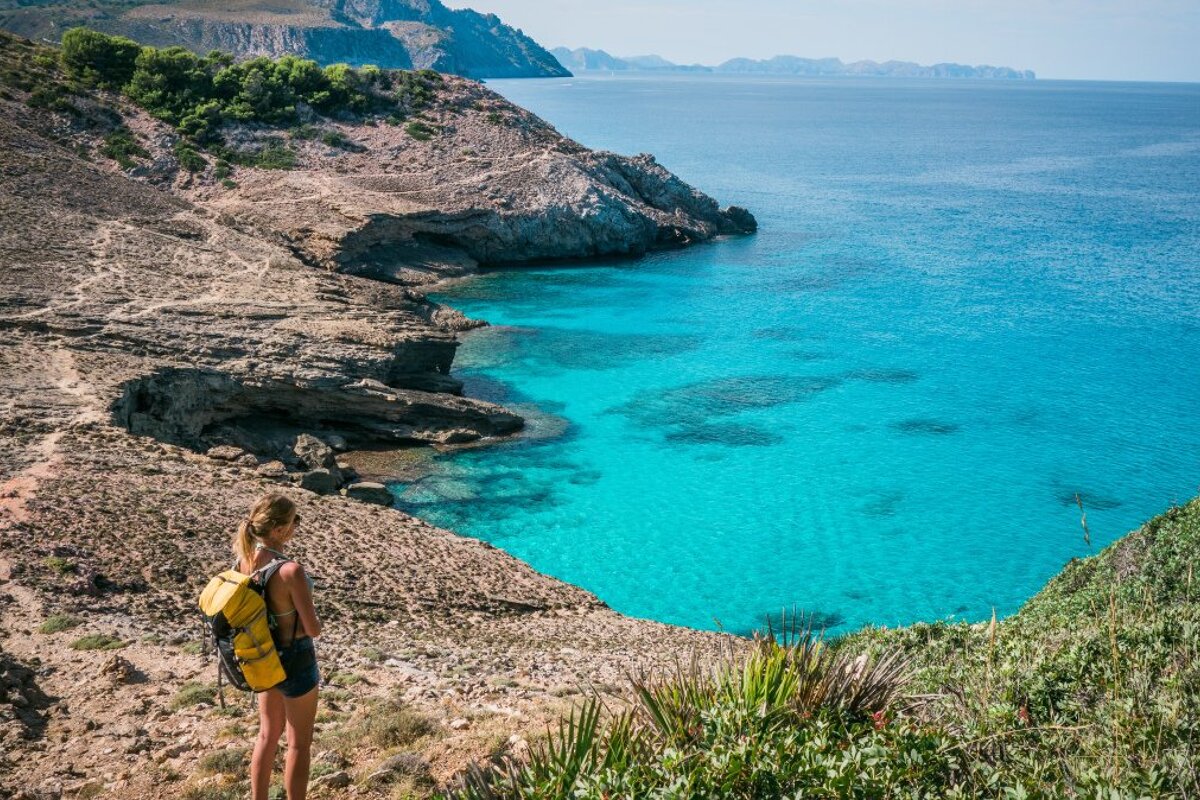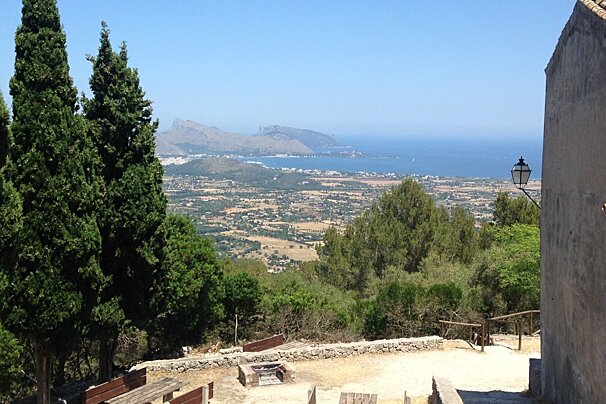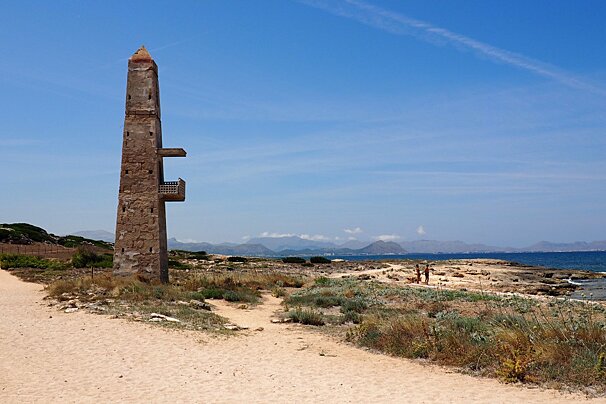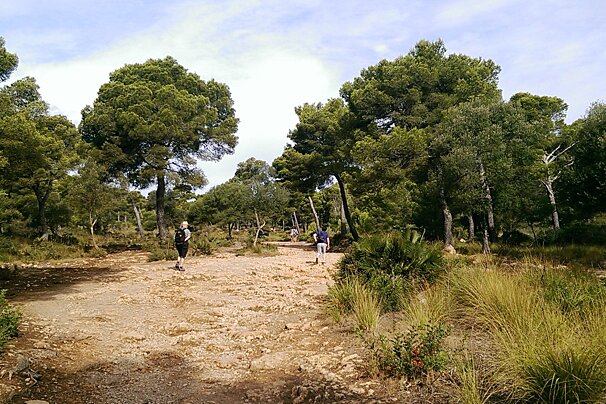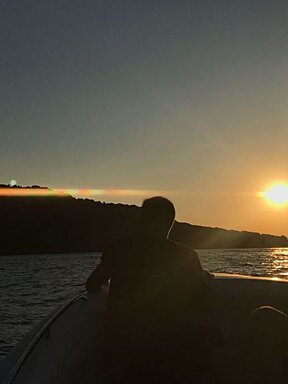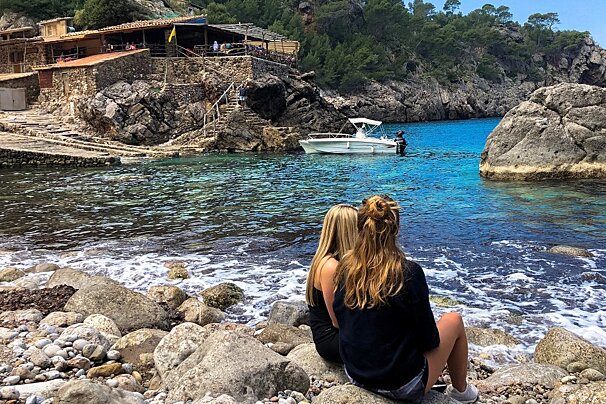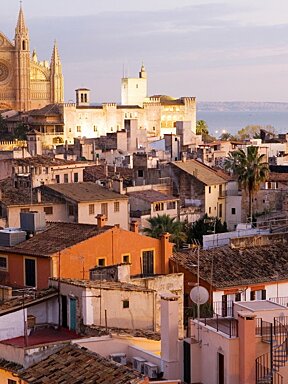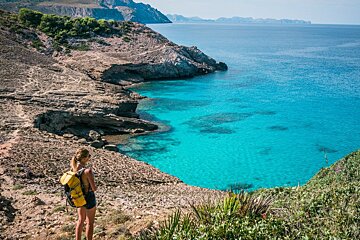
© Ilona Antina Photography

© Ilona Antina Photography

© Ilona Antina Photography
Hiking in Mallorca
Discover the top Mallorca walking areas
You're spoilt for choice when it comes to walks and hikes around this beautiful island. Challenging mountain hikes, gentle seafront paths and picturesque country trails are all available here. You can tackle them alone or, if you want to learn all about the Mallorcan landscapes and discover hidden corners, book a tour.
Once the summer season is over, Mallorca becomes a hive of activity for not only those clad in lycra cycling gear but also for ramblers, climbers and deep water soloists. The dramatic Serra de Tramuntana mountain range in west Mallorca and the more modest Serra de Llevant mountains in the east see more walkers each year, so grab those hiking boots from the cupboard and given a quick dust-off before packing your bags to visit the island.
Even if walking and hiking in Mallorca has become more popular in recent years, most paths and routes are still very quiet and you'll often feel like you have the whole place to yourself and a couple of mountain goats! There are relatively easy paths suitable for beginners, whilst other hiking trails take you to the five summits that reach over 1,000m, perfect for keen walkers looking for a challenging route.
Worth knowing
The best time for hiking is probably late summer/autumn, or spring when the temperatures are slightly cooler and the crowds have disappeared. Spring is also a wonderful time to walk through the countryside when flowers and greenery fill the landscapes. Late summer and autumn may not be so green, but it is still warm enough for a swim should you happen to come across a hidden bay.
The Regional Government have invested a great deal of money in developing trails to make walking in Mallorca much more accessible. Many paths that exist already are marked out with wooden sign posts every few kilometres. You do have to watch where you are going when walking in Mallorca, as some 800 years ago the entire island was claimed as private property and, although many paths are accessible to the public, some areas are split by gates or fences that must be closed behind you. Please do not trespass if there are clear signs not to do so!

Walking / Running hotels & hostels
Not only does Mallorca have some of the best mountain hiking trails, but the island also claims some first class boutique hotels. If you want to indulge in a little extravagance after your hike, then we would highly recommend staying in one of these. The west of Mallorca is the most densely populated when it comes to boutique hotels but you will find some pretty impressive options wherever you decide to visit.
If you want some more budget-friendly accommodation whilst hiking around the island, check out some of the different refuges found in around the island. Some of the most well-known are located at the end of each stage of the Dry Stone Route. There are around a dozen well-known refuges in this area with all the basic amenities you might need including a hot shower, a bed and breakfast. Such refuges are usually historic buildings with many hiking trails on their doorstep perfect for walking enthusiasts. You can book this type of accommodation through the Consell de Mallorca.

Walking trails & routes
Enjoy any one of the coastline walks and admire the sea with its hidden coves and crystal blue waters or try some more challenging mountain trails and discover pure water fountains, wild goats and stalagmite caves. You may even spot one of Spain's rare breeds - the eagle.
Puig de Maria (North Mallorca)
If you're looking for a walk near Pollença, the route to the Puig de Maria hill might be of interest to you as it offers some of the best panoramic views over the area. The trail is just over 2km from Pollença but can be steep in places. Right at the top lies a historic sanctuary turned hostel, the ‘Santuari de la Mare de Déu del Puig’, where after around a 45-minute walk, you can reward yourself with some lunch and a drink. There is also the opportunity to stay here if you're keen for a little overnight adventure. Being a fairly easy route, this walk is doable whatever the season, even the peak of summer.
Alcúdia to La Victòria Hermitage (North Mallorca)
The Alcúdia to La Victòria Hermitage is a route of around 7km, popular thanks to the breathtaking views over the Bay of Pollença and the Formentor peninsula from the 14th-century chapel. La Victòria Hermitage offers boutique accommodation for travellers keen to make the most of the experience. There are also numerous coves to indulge in a spot of swimming on the descent down to sea level.
Ermita de Betlem to Can Picafort (East Mallorca)
The moderate level coastal hike from the Ermita de Betlem, near the beautiful village of Artà, to Can Picafort is one of the best routes to be found in the north east of the island. The main highlight along the path is the prehistoric remains of the municipality of Santa Margalida, dating back to around 500-10BC. There is the opportunity to walk for up to 3.5 hours along the coastline and through a couple of villages on the way. It's the type of route you can stop at any time and just turn back, and you can take a little swim or a coffee break on your walk too.
Felanitx to San Salvador (East Mallorca)
The route from Felanitx to the Monastery of San Salvador, in the direction of Porto Colom, is a 12km trek offering walkers a longer, more challenging trail with plenty of uphill climbs. The views over the south eastern coast of Mallorca and the island of Cabrera in the north from the Monastery are well worth the trip.
The Archduke’s Trail (South Mallorca)
Starts from Valldemossa and is on every keen walker’s bucket list. It’s so-named because the Archduke Luis Salvador built the paths that reach nearly 1,000m high into the mountains. The circular route can be up to 17km, so it isn’t one for the faint hearted, but it's well worth the challenge as hikers are accompanied by overwhelming mountainous back drops.
Puig de Randa (South Mallorca)
From the village of Randa in the area of Llucmajor, this 6km hike up to the monastery at the top of Puig de Randa is a secluded and interesting trail. An abandoned tunnel and three monasteries are all along the route, with the monastery at Puig de Randa featuring a café ready to serve walkers as they complete their climb.
The Old Postman’s Route (West Mallorca)
The Old Postman's Route from Esporles to the ancient terraced village of Banyalbufar is one of the famous walks in the west of the island. Discover ancient Moorish terraces, fantastic sea views, a natural spring, holm oak woods, olive groves and a glimpse of Mallorca’s wine growing community. It’s quite an easy walk with a few climbs and cobbled surfaces which should take around 2.5 hours to complete.
Ruta de Pedra en Sec (Dry Stone Walk - GR 221 - West Mallorca)
You have probably heard of the GR 221 Dry Stone Walk if you are interested in hiking as it is Mallorca's most famous route. If you really feel like a challenge, this is a long distance hike 135km route split into eight stages through the Serra de Tramuntana mountains. Some parts are accessible without a guide, however, areas such as the Esporles to Valldemossa and Valldemossa to Deià stages are better done with someone who knows the path. This is due to the incomplete signposts which can mean taking the wrong route is quite easy. The Consell de Mallorca has invested money in renovating refuges at the end of each stage to provide hungry hikers with a meal and local wine after a tough day walking. (You can book them online). If you’re renting a car then getting around can be very easy and parking is often available in local towns or right by the bottom of the start of the hiking path.

City Walks in Mallorca
Palma is the island’s capital city and the perfect size for walking around. Many of the historical sights are found on tiny, pedestrianised streets so walking is definitely the best way of exploring the city. There are various different walks available, favourites include:
The History and Architecture Walk: Completely mesmerising, you will see centuries of architecture, from Gothic through to Modernist including Arab baths, shipyards and the kings palace next to the cathedral. There’s also plenty of opportunity to replenish at one of the city's many cafes, which can be found almost on every street. Just try to not to get lost in the maze of streets in Palma’s old town, we highly recommend bringing a map with you. Find out more.
The Sea Front Walk: To escape the maze of cobbled streets in the enchanting city centre, take a stroll along the city’s promenade. There are more opportunities to pick up your pace whilst soaking up the Mediterranean sunshine and views over Palma's magnificent harbour, and there are plenty of cafes and restaurants along the Paseo Marítimo, so you can take a leisurely stroll and bar hop at the same time. Find out more.

National parks routes
There are several protected natural parks on the island of Mallorca, each offering a different landscape and featuring local flora and fauna. They can be easily explored on foot.
Llevant Natural Park
The magnificent mountains of the Serra de Llevant are located in the north east of Mallorca. Here you can find beautiful walks around Cala Ratjada or Artà where you can visit calas with stunning blue seas. Often on a clear day, you can see the smaller Balearic island of Menorca. These mountains are only around 500m, with the highest peak being the ‘Puig de la Talaia Freda’ which reaches 562m. This hilly Natural Park has coastal views with beaches such as Es Matzoc, Cala Font Celada and S’Arenalet d’Albarca all being within the park area. There are eight routes through the park, all of various lengths and some join together to take you from the starting point to the beach areas. The paths include several overnight hostels each with their own charm and set in the natural park environment. There is also a small camping area here near the 'La Caseta des Oguers' area of the park.
Cabrera Natural Park
The Cabrera Islands lie 10km off the south-east corner of Mallorca and form the protected Maritime-Terrestrial Natural Park. The ecosystems here have been well protected and preserved, and the 14km coastline around the main island offers coves and inlets while the highest peak is only 172m. There are several hikes where you can visit the ruined castle, the lighthouse or numerous caves. Access to these islands must be arranged with the park rangers in advance and only the boats which leave from Colonia de Sant Jordi daily during peak season are authorised to reach the islands. More details can be found on our Cabrera Natural Park page.
Mondragó Natural Park
Located near the Santanyí region, this 785-hectare national park is mainly privately owned. Walks in Mondragó Natural Park range from 25-40 minutes, each sampling varied vegetation and surroundings. One path rises to the top of a coastal cliff to views well worth the walk, another takes you up the side of a ravine to the viewpoint at 'Ses Fonts de N’Alis' where the damp conditions allow unusual vegetation to grow. There are also a few trails that include a bird observatory and paths that cross small fields and pass by old waterwheels.
Sa Dragonera Natural Park
The island of Sa Dragonera is steeped with history as the Moorish pirates used it as a base for attacking the Mallorcan coast. The terrain here is very dry due to a shortage of water and effects of the salty sea hitting the rocks, which also means that scenic cliffs have formed on the island. There are three main trails, all departing from Cala Lledo. From here, head to the Llebeig lighthouse, a 4.5km walk along a path to the south of Sa Dragonera, or towards the Vell lighthouse, a 2.8km rocky path where walking shoes are recommended. Last but not least, the shorter half an hour walk to the Tramuntana lighthouse might appeal to you.
Serra de Tramuntana
The Serra de Tramuntana mountain range creates the ‘backbone’ of Mallorca spanning from the south to the north along the whole western part of the island. Awarded World Heritage Status by UNESCO in 2011, the Tramuntana mountains are recognised for their physical and cultural significance to the island. The highest peak in Mallorca’s largest mountain range is the Puig Major with a height of 1,445m which is, unsurprisingly, the highest mountain in the whole of the Balearic Islands. The mountains are made from limestone and offer many crags for climbing as well as walking.

Safety advice
If you come into any difficulty whilst walking in the hills, there is a mountain rescue service available, call 112. This service is free but you should always have travel insurance which includes any activities that you may be undertaking whilst visiting Mallorca.
Footpaths in Mallorca are very well maintained and signposted, however, you should always exercise caution when venturing into nature. For that reason, it is particularly recommended that you:
- Are as physically fit as possible - Ensure you are fully aware of your limitations and of those accompanying you, especially children and elderly people.
- Are appropriately equipped - Choose sturdy footwear with ankle support, warm, water repellent clothing (even if the sun’s been beating down for days), sun cream, sunglasses, map, plenty water, food and snacks, first aid kit....
- Check your itinerary with the Tourist Office - Even the easiest and best-marked trails can present unexpected hazards such as rock slides.
- Allow plenty time for your chosen route - Additionally, leave an extra margin in case of an incident. Let someone know where you are going and when you expect to be back. Nightfall may take you by surprise so it is wise to carry a flashlight.
- Stay on the marked trails - This is especially important on steep slopes or precipices. Never take short cuts as doing so causes erosion, channelling the rain water and resulting in deterioration of the trails that are so hard to maintain.
- Check the weather forecast - It is always advisable to check the weather forecast before setting off as this can greatly affect your walk or hike.
- Respect the environment - The surroundings here are breathtakingly beautiful but the balance of nature is very fragile. In order to maintain the beauty of Mallorca don’t light fires, ensure you take your rubbish with you, leave the flowers for others to admire and avoid making excessive noise that may disturb the wildlife.
- Ensure your dog is kept on a lead where necessary - Look out for signs requesting that you keep your dog on a lead. Some areas are prohibited to dogs altogether to protect local wildlife.
Easy summer hikes in Mallorca
Believe it or not, Mallorca is one of the trendiest hiking holiday destinations in Europe right now. Whilst spring is the favourite time of year for walkers to get their boots on, there are plenty of shorter and easier walks for those seeking a...
Guided Walk from Deia to Port de Soller
Mallorca certainly has its fair share of tourist resorts, but there is much more to this island than mere beaches. Literally hundreds of hiking trails criss-cross the island, offering dramatic scenery, a glimpse of authentic rural lifestyles and a...
Hiking Mallorca's Highest Accessible Peak
It is common knowledge that in order to find the best views of anything, one needs to go up! I am certainly a firm believer in this theory and it was with this goal that I set out one Sunday afternoon to reach the top of the island!
Walk from Cala Agulla to Cala Mesquida
The east coast of Mallorca is well worth exploring with its blue flag beaches, Llevant Natural Park and hiking trails for all levels. There are several signposted walks which can be accessed from both Cala Mesquida and Cala Agulla.
